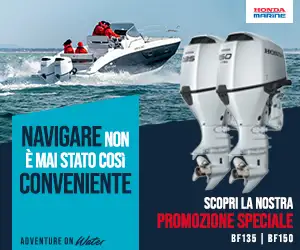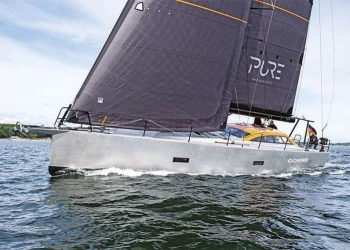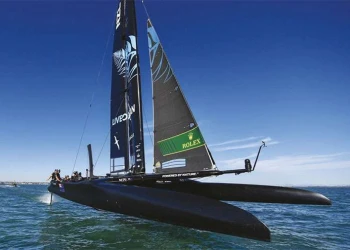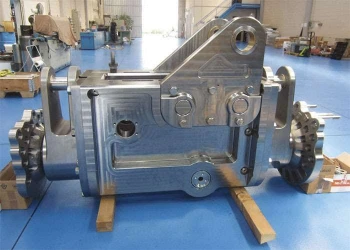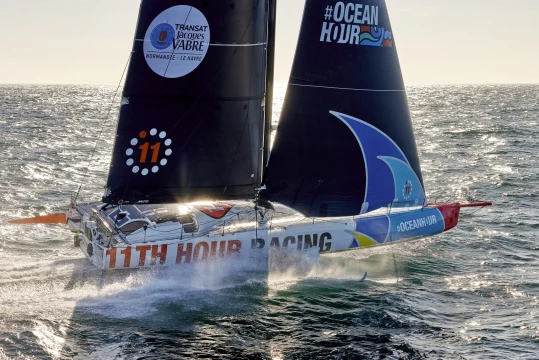
With their new Imoca 60, Malama, 11th Hour Racing Team has set an important benchmark for the carbon footprint and environmental impact of new raceboat builds.
Environmentally driven 11th Hour Racing Team’s latest Imoca 60
You’d expect the environmentally-driven 11th Hour Racing Team to push harder than most when it came to building their latest Imoca 60. They did not disappoint...
There’s a quick, cost-neutral and almost effortless way to massively reduce the environmental impact of building a high-performance sailing yacht. For an Imoca 60 you can cut the total carbon footprint by almost a third, simply by ensuring that the boatyard and key suppliers are on a 100 per cent renewable electricity tariff. It’s usually easy to switch energy suppliers and renewable energy is becoming very competitive in price, so it can be a triple bottom line win – for the client, for the builder and for the environment.
That’s one of the key findings from 11th Hour Racing Team’s project to design and build a new Imoca within the current class rules, without compromising on performance. They’ve set an important benchmark, explored alternative materials and compared the impact of build methods. They’ve calculated the total footprint of a grand prix raceboat build and its entire supply chain with greater accuracy than has ever been done before. And now they’ve published their findings in a Design & Build Report that’s freely available online.
With life cycle assessment soon to be mandatory for new Imocas and environmental initiatives afoot in other grand prix classes, it’s time for sailing teams and their suppliers to get serious about sustainability. 11th Hour Racing Team’s Design & Build Report provides a roadmap, a template and a significant shortcut for other racing teams, boatbuilders, boat owners and marine industry suppliers. ‘Pooling our knowledge is a huge part of this and we need to get together rather than running down the road in parallel,’ says Wade Morgan, the America’s Cup and Ocean Race sailor who now works as 11th Hour Racing Team’s build manager. ‘We’ve got to talk to each other, bring it into the circle, share our mistakes as much as our successes.’
To mark the release of the Design & Build Report, Seahorse has compiled some insights and advice from the key people who researched and produced it, along with some useful lessons learned from their own recent raceboat build at CDK Technologies in Brittany.
You need to start earlier than you think
The four-year cycle of a typical ocean racing campaign just isn’t long enough to achieve major gains in sustainability or reductions in footprint within the status quo of build timelines and the focus on performance. ‘To implement a new build process would require at least an additional 18 months of trialling new materials, testing them for reliability in the boatyard and out on the water, and working in the engineering space before you have a product in which you can have confidence,’ says 11th Hour Racing Team’s sustainability manager Damian Foxall.
‘Even though we began a long time ahead of The Ocean Race start, it was already too late to do something radically different in terms of materials or process that wasn’t incentivised by the rules,’ Foxall says. ‘What we did have was an opportunity to explore many aspects of sustainability while going through business as usual like any other team. Unlike other teams, we have an extra mandate from our sponsors, 11th Hour Racing, to go above and beyond to see what’s possible.’
Put sustainability in the design brief
‘It needs to start with the naval architect,’ says Etienne Le Pen, who conducted the on-site research for the team’s lifecycle analysis as part of his masters degree. ‘It is the architect who designs the boat and the engineer who decides what materials to use. By the time the plans get to the boatyard everything is pretty “locked in”. With about 70 per cent of the build footprint due to the ubiquitous use of carbon fibre and epoxy, the ability to make change is largely in the hands of policy makers and class rules.’
Design offices should also be on a 100 per cent renewable energy tariff. ‘Computing power accounts for 3-5 per cent of the total build footprint,’ says Amy Munro, the team’s sustainability officer. ‘That’s more than the footprint of transport logistics in the build phase and it’s only going to increase. So it’s important to consider energy use for things like CFD. What energy are the supercomputers running on?’

It is key to design and build for longevity and reuse. ‘To a certain extent this principle is already embedded in the philosophy of the Imoca class,’ Foxall says, ‘and before we discuss other, more complex points to reduce impacts, reuse is singularly the most effective way to minimise all impacts. Simply put, a boat or component that lasts twice as long has half the footprint, and this is the scale of reductions we need.’
Build in the right place
One of the advantages for 11th Hour Racing Team choosing to build at CDK Technologies, in Brittany was the significant reduction in transport footprint. ‘About 90 per cent of the materials came from suppliers within a 50km radius of the yard,’ says CDK production manager Michel Ollivier.
‘An important first step was to conduct a full infrastructure audit, which highlighted the significant work that CDK Technologies had already done to improve their sustainability as a result of their staff asking them to do it,’ Foxall says. ‘As part of that process we were reassured to find a well-developed material sourcing, resource recovery and waste management plan. The outcome which is quite exceptional in the boatbuilding world is that almost no waste went to landfill from CDK Technologies.’

Focus on plugs and moulds
‘Half of the total footprint of a boat coming out of the build shed is in the plug and moulds,’ Foxall says. ‘We can make a difference here. In the next build cycle we should no longer be using male plugs, and alternative materials such as flax and/or recycled carbon can be used in non-structural parts of the moulds.’
Morgan agrees. ‘The mould doesn’t go sailing,’ he says. ‘There should be a rule that you have to build it out of recycled carbon. Given the timing of The Ocean Race, it wasn’t feasible for us with any of the suppliers but we’ll definitely look to be doing it in the future.’ Hull skins for several inshore racers have already been built using recycled carbon moulds, but for CDK’s Ollivier the timeline of this build did not allow time to explore this further. This again underlines the need for class rules to mandate these solutions for designers and builders.
Hull and deck moulds are obvious candidates for reuse. ‘With Maitre Coq, another Imoca team using our own moulds before we had even left the shed it was like hot bunking during an ocean race,’ Foxall says. ‘It’s an efficient use of boatyard labour, energy and the mould itself. By reusing a mould Maitre Coq saved 171 tC02e (metric tons of carbon emissions), more than 30 per cent of their overall footprint.’
Use new materials in careful steps
‘You can’t usually save weight, save money, save carbon footprint and increase usability all in one,’ Morgan says. ‘Balancing those factors is what I do. We didn’t want to introduce a core, a fibre, a resin all in one. If we try and do everything in one go then we no longer have a baseline. If something delaminates, is it the fibre, is it the resin, is it the core? So for the first parts we made we used resin from Gurit and Nomex core – both very well known – and we used flax for the fibre. That went very well. For the next move, making fully recycled cradle splashes, I said let’s use recycled carbon, recycled PET core, and let’s use the best bio resin we can.’
Recycled PET core material has a real future, Morgan says. ‘Not in the structure of a hull just yet, but it sands well, machines well. It has forming capabilities for curved furniture panels, its adhesion is good, and it doesn’t seem to want to delaminate.’ He is unconvinced, however, about bamboo fibre: ‘Any product that won’t absorb resin scares me. It’s too hard to use. On the other hand we did incorporate some nice non-structural components made out of flax, which allowed us to pilot the new Imoca rule incentivising the use of alternative materials on board.’

Find a use for carbon offcuts
Offcuts from 11th Hour Racing Team’s Mālama and other new builds at CDK Technologies are being recycled for use in the building industry. The snag here is that location is key for recycling. With a big aircraft factory as well as the yacht racing industry, west Brittany is one of the few places where enough carbon offcuts are produced to make a viable feedstock for a recycling company.
Keep a small stock of alternative materials
‘If you don’t have them on site, you’ll never start using them,’ Morgan says. Munro points out that a lot of parts are made from carbon simply because it is lying around, when a more sustainable – and cheaper – material would do just as well.
Sustainability can be good for business
CDK Technologies has saved about €8,000 per build by improving its recycling. ‘Four years ago we set up a garbage separation system with coloured bins,’ says deputy general manager Yann Dollo. ‘It was a suggestion from the guys in the shed, not a command from management. We’re spending less on refuse collection, which was a surprise. We’ve reduced the volume of waste and we’re reusing part of it.’ Gaining a reputation for recycling also helped the yard win a contract to build 80m carbon masts for a new fleet of sailing freighters.
A key initiative setup between CDK Technologies and one of their major suppliers highlights the value created by collaboration. They stored cardboard packaging on site, and then sent it back as a full shipment to the supplier, which saved CDK more than €4,000 in waste management, avoiding the purchase of packaging from the supplier, and avoiding one metric ton of greenhouse gas emissions. This is the net result, and takes into account the impact of return shipment, highlighting that some of the best solutions are both economically and environmentally beneficial.
Class rules have to change
‘Without incentives to change, the primary design and build criteria will always be performance ,’ Foxall says. ‘There is an unavoidable requirement for classes and event organisers to take the lead and set strong policy and place sustainability within the design spec. Sailors are inherently innovative, by placing sustainability within the design brief we unlock this capacity and give our designers and builders permission to find the best sustainable solutions.

‘Lifecycle assessment is just a measurement tool, the objective is to highlight the hotspots and then do something about them. Future builds need to be done with a carbon cap, leaving enough scope for designers and builders to avoid creating an IOR-type situation with secondary effects. Finally, setting an internal price on greenhouse emissions can create a mechanism which supports good policy. Teams initiating new builds could be charged as “polluter pays”, reuse of boats and their components would be incentivised as zero impact - zero cost thereby supporting smaller teams and budgets, and the funds generated would support reduction programs such as recycling and coordinating better boatbuilding,’ Foxall explains.
‘A key topic within the Imoca class are the foils, says Le Pen. ‘At approximately 100 tC02e per set, [+/-20 per cent the overall impact of a boat launched and ready to sail], foils also represent a large part of the waste, man hours and resources within an Imoca team campaign. Again, without a check-balance on performance, external secondary impacts have skyrocketed, and while most people would still like to keep Imocas “flying” we need to do this with a more sustainable approach within the class rule.’
Some positive changes are already under way, as CDK’s Ollivier points out: ‘Until recently, the culture in the industry was that you sourced and used everything you wanted without thinking about it, even if the cost was very high. It was normal to transport one piece of Nomex all the way through Europe on a truck just to make a small part because the naval architect said it would save a hundred grams. Now that is unthinkable.’
